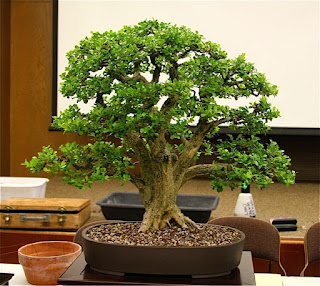Boxwood Bonsai Trees
Boxwood Bonsai Tree Care Guide
Pruning Tips:
A clip-and-grow approach makes boxwood bonsai easy to train and trim. Cut fresh shoots by 2-3 pairs. This ensures the branch has wood to support bud formation. Fill pad layers with directional pruning. Even when cut hard, boxwood regrows easily.
Fertilizing:
We recommend fertilizing your tree every month with bonsai fertilizer. Seasonal time release granules are the easiest to utilize. Reduce fertilizer in the winter. Overfertilizing can scorch leaves.
Lighting:
Boxwood Bonsai trees need sunlight. Boxwood bonsai prefers filtered to full sun. Sunlight makes the foliage larger and thicker. Sunlight can scorch leaves.
Temperature Requirements:
Boxwood bonsai thrives in heat and cold. They are hardy in numerous temperatures and circumstances.
Watering Requirements:
Boxwood bonsai needs light irrigation. We suggest softly soaking the soil. Make sure water reaches the dirt and roots by draining the pot.
Repotting:
Boxwoods can be repotted in spring and fall. Winter repotting hinders root growth. Trim older roots to promote new growth while repotting. As Bxwood expands, repot it. Depending on growth, every 2-3 years.
FAQs
How often should I water my boxwood bonsai?
Boxwood bonsai needs plenty of water throughout growth. These hardy trees can withstand dry spells. Avoid waterlogging the roots. Optimize moisture levels. Never allow the root ball to dry up, and avoid oversaturated soil.
If the soil is bone dry, water it. To water the tree, set it in a shallow pan or wash basin. Let the plant soak up moisture for 5 to 10 minutes. If top-watering, moisten the bonsai and soil, then repeat.
Can boxwood bonsai be grown indoors?
The Chinese boxwood bonsai does well indoors. European boxwood thrives outdoors. See Types of Boxwood Bonsai below for more information on overwintering each species. Our beginner's guide to indoor bonsai explains how to care for the best indoor plants.
How much light do boxwood bonsai need?
Boxwood bonsai can tolerate variable light levels, which is a plus. They enjoy sunlight during the growing season, like other trees. They can survive in semi-shade or low light indoors. Your tree will appreciate a shady afternoon break during the hottest summer days. Evergreen leaves burn in direct sunlight.
How do you prune boxwood bonsai?
Boxwood is a popular wood for wind instruments and chess pieces since it's robust and resilient. Heavy pruning should begin in midspring when new growth begins. Thinning the outer canopy can help sun-starved inner foliage.
Boxwoods' rough bark is ideal for bonsai. You'll want to start wiring when the shoots are young and supple because their wood is firm. Leave wiring on during the growing season to guide recalcitrant branches, but don't damage the light bark. Marrs and bites are permanent.
How often should I repot boxwood bonsai?
Boxwoods have dense, shallow roots and repot well. Your tree should be repotted every two to five years. When the tree is young, repot it more often; as it becomes older, space it out. Boxwoods do best when repotted when they emerge from winter slumber.
Can you defoliate boxwood bonsai?
Boxwoods have little leaves naturally, which helps them as bonsai. As your tree matures, you may want to further prune its leaves. Defoliation is the removal of new tree leaves. It's preferable to do this in early June so your tree can recover before winter. Full defoliation can kill a tree's leaves.
Are boxwood bonsais poisonous?
Dogs and other animals are poisoned by bonsai trees.Depending on dose, symptoms include stomachache to death. Bonsa and pets should be kept fully separate. If you have an indoor pet, grow your trees outside or in a specific room.
Types of Boxwood Bonsai
Over 70 types of boxwood trees exist, but the Chinese and European common boxwoods reign supreme in bonsai. It's crucial to know the distinctions between the two species to provide the correct care.
Common European Boxwood (Buxus sempervirens)
Europe-wide, boxwood is a popular landscaping plant. It's trainable and the faster-growing species. Boxwood grows outside and tolerates frost. If temps drop below freezing, transfer it somewhere cool to overwinter.
Boxwood is dormant in winter and doesn't need fertilizer. Evergreen boxwood retains leaves all winter. Light frosts may yellow or pale the leaves, but they'll return in spring.
Chinese boxwood (Buxus harlandii)
Although hardy, Chinese boxwood is more fragile than its European cousin. This species thrives indoors but prefers the outdoors in warmer months. A Chinese boxwood should never be left outside to overwinter; instead, place it in a cool location with temperatures around 50 degrees F. These trees don't go dormant and need monthly fertilization.
